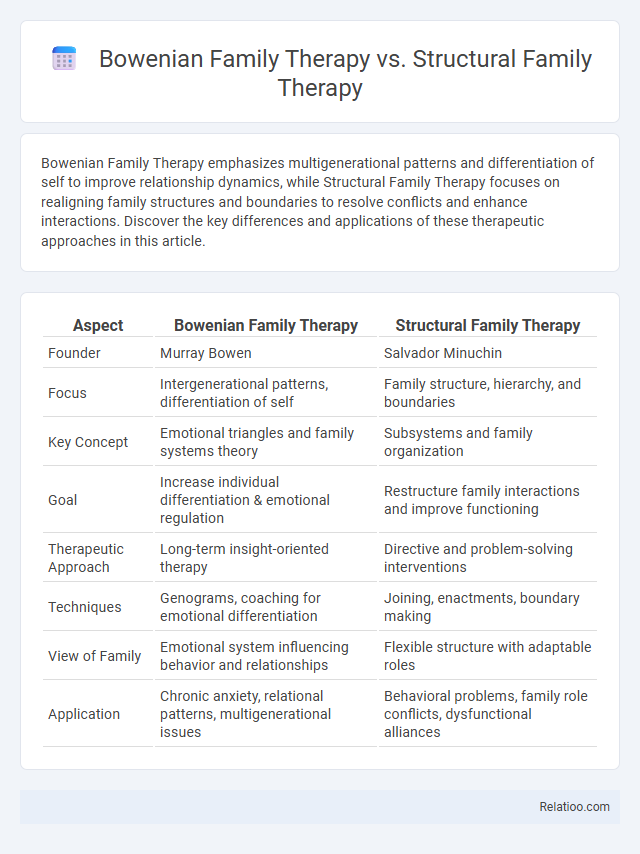Bowenian Family Therapy emphasizes multigenerational patterns and differentiation of self to improve relationship dynamics, while Structural Family Therapy focuses on realigning family structures and boundaries to resolve conflicts and enhance interactions. Discover the key differences and applications of these therapeutic approaches in this article.
Table of Comparison
| Aspect | Bowenian Family Therapy | Structural Family Therapy |
|---|---|---|
| Founder | Murray Bowen | Salvador Minuchin |
| Focus | Intergenerational patterns, differentiation of self | Family structure, hierarchy, and boundaries |
| Key Concept | Emotional triangles and family systems theory | Subsystems and family organization |
| Goal | Increase individual differentiation & emotional regulation | Restructure family interactions and improve functioning |
| Therapeutic Approach | Long-term insight-oriented therapy | Directive and problem-solving interventions |
| Techniques | Genograms, coaching for emotional differentiation | Joining, enactments, boundary making |
| View of Family | Emotional system influencing behavior and relationships | Flexible structure with adaptable roles |
| Application | Chronic anxiety, relational patterns, multigenerational issues | Behavioral problems, family role conflicts, dysfunctional alliances |
Introduction to Family Therapy Approaches
Bowenian Family Therapy emphasizes multigenerational patterns and emotional interdependence, helping You understand family dynamics through differentiation of self and family triangulation. Structural Family Therapy focuses on reorganizing family structures and interaction patterns by assessing boundaries, hierarchies, and subsystems to improve communication and function. Family Therapy as a broader term encompasses various approaches aimed at resolving family conflicts, enhancing relationships, and promoting systemic change to support Your overall family well-being.
Overview of Bowenian Family Therapy
Bowenian Family Therapy focuses on multigenerational patterns and emotional interdependence within families, emphasizing differentiation of self to reduce anxiety and improve relationships. Developed by Dr. Murray Bowen, the approach addresses family dynamics by exploring genograms and promoting insight into family roles and unresolved conflicts across generations. This contrasts with Structural Family Therapy, which emphasizes reorganizing family hierarchies and boundaries to improve functioning, while general Family Therapy encompasses various models aimed at enhancing family communication and problem-solving.
Overview of Structural Family Therapy
Structural Family Therapy, developed by Salvador Minuchin, emphasizes reorganizing family dynamics and boundaries to improve interactions and resolve conflicts. It examines subsystems within the family, such as parental and sibling relationships, focusing on clear hierarchies and roles to promote healthier functioning. Unlike Bowenian Family Therapy, which centers on multigenerational patterns, Structural Family Therapy targets present family organization and transactional patterns for change.
Core Principles of Bowenian Family Therapy
Bowenian Family Therapy centers on differentiation of self, emotional triangles, and multigenerational transmission processes, emphasizing understanding family dynamics across generations to promote individual growth. Structural Family Therapy, in contrast, focuses on boundary setting, hierarchy, and subsystem organization within the family to realign interactions and improve function. Your therapy choice should consider Bowenian principles if you seek deep exploration of family emotional systems and generational influences.
Core Principles of Structural Family Therapy
Structural Family Therapy centers on organizing family interactions and hierarchies to improve relationships and resolve conflicts, emphasizing boundaries, subsystems, and roles within the family system. Bowenian Family Therapy focuses on differentiation of self, multigenerational patterns, and emotional system regulation, while general Family Therapy integrates diverse techniques tailored to the family's unique dynamics. Core principles of Structural Family Therapy include restructuring family organization through clear boundaries, strengthening parental alliances, and realigning family hierarchies to promote healthier communication and functioning.
Therapist’s Role in Bowenian vs Structural Methods
The therapist's role in Bowenian Family Therapy centers on promoting differentiation of self and emotional detachment from family anxieties, acting as a calm, neutral observer facilitating insight into multigenerational patterns. Structural Family Therapy requires the therapist to actively intervene, restructure family hierarchies, and realign subsystem boundaries to improve family functioning and resolve dysfunction. Your therapist in Bowenian methods encourages awareness and self-regulation, while in Structural approaches, they lead dynamic interventions to enact behavioral changes within the family system.
Techniques and Interventions: Bowenian vs Structural
Bowenian Family Therapy techniques emphasize differentiation of self, genogram construction, and exploring intergenerational patterns to promote insight and emotional regulation within your family system. Structural Family Therapy interventions focus on reshaping family hierarchies, realigning subsystems, and modifying interactional patterns through enactments and boundary setting to improve family functioning. Both approaches utilize strategic interventions, but Bowenian therapy primarily targets emotional processes, whereas Structural therapy concentrates on restructuring relational dynamics.
Strengths and Limitations of Each Approach
Bowenian Family Therapy emphasizes intergenerational patterns and differentiation of self, helping Your family navigate emotional fusion and chronic anxiety but may be limited by its longer-term process and less focus on immediate behavioral change. Structural Family Therapy targets family organization and boundaries, effectively restructuring dysfunctional dynamics for rapid behavioral improvements, yet it can overlook deeper emotional underpinnings and individual differentiation. Family Therapy, as a broader category, integrates various techniques to address diverse relational problems, offering flexibility but sometimes lacking the specificity and depth provided by Bowenian or Structural approaches.
Suitability for Different Family Dynamics
Bowenian Family Therapy is suitable for families dealing with multigenerational patterns, focusing on differentiation of self and emotional interdependence, making it ideal for complex relational histories. Structural Family Therapy works best with families needing clear boundaries and hierarchy adjustments, emphasizing family subsystems and organization to address dysfunction effectively. Your choice should align with the specific family dynamics present, where Bowenian aids insight into generational influences, while Structural promotes restructuring interactions for immediate behavioral change.
Conclusion: Choosing Between Bowenian and Structural Family Therapy
Choosing between Bowenian and Structural Family Therapy depends on your goals and family dynamics. Bowenian Therapy emphasizes understanding generational patterns and emotional interdependence, making it valuable for long-term relational insights. Structural Therapy focuses on modifying family organization and boundaries, offering practical interventions to reshape dysfunctional interactions for immediate change.

Infographic: Bowenian Family Therapy vs Structural Family Therapy
 relatioo.com
relatioo.com